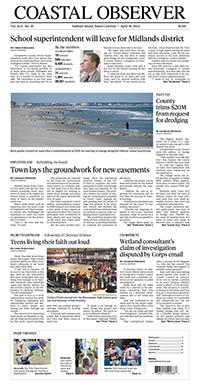Environment
Call for county wetlands ordinance follows Supreme Court ruling

A crucial element of Georgetown County’s resilience plan was dealt a setback last week with a U.S. Supreme Court ruling that limited federal regulation of wetlands. In a case from Washington State, the court ruled that the Clean Water Act only applies to wetlands with “a continuous surface connection” to navigable waters.
That will roll back protection for wetlands that lack a direct connection to the so-called “waters of the U.S.,” said Amy Armstrong, executive director of the S.C. Environmental Law Project.
The ruling was handed down as consultants took comments on a draft of the resilience element of Georgetown County’s comprehensive plan. The element recommends that the county continue to work to preserve fresh and salt water wetlands. “To ensure their safety for years to come would be an incredibly productive way to prevent a decline in natural resilience for the county,” it states.
Although no one has trouble defining wetlands, “we’ve fought over what wetlands are part of the waters of the U.S.,” Armstrong said.
The Environmental Protection Agency and the Corps of Engineers enforce the Clean Water Act, with the Corps responsible for issuing permits for dredging or filling protected waters. In the opinion by Justice Samuel Alito, the court said the agencies have expanded the definition of waters of the U.S. even after a series of court challenges that sought to limit their authority.
“The agencies later admitted that ‘almost all waters and wetlands across the country theoretically could be subject to a case-specific jurisdictional determination,’ ” the ruling states.
But the court decided that the act “extends only to those wetlands that are ‘as a practical matter indistinguishable from waters of the United States,’” citing language from a prior ruling.
While the court proposed a two-part test to determine which wetlands are covered, “we can clear up a lot of that uncertainty in Georgetown County by saying we’re going to protect all the wetlands in the county,” Armstrong said.
Creating a local wetlands ordinance was among the recommendations included in an update of the natural resources element of the comprehensive plan, but approval of that element was deferred by County Council after the version recommended by the Planning Commission was revised by county staff.
The resilience element, which was added in 2020 to the list of nine elements required by state law, includes a recommendation for wetlands protection, said Meredith Johns, one of the consultants who helped prepare the draft.
“That could be further developed,” she said. “We see that as very important in resilience planning.”
The county hired the St. Bernard Project, a nonprofit, to help draft the resilience plan. It looked at an array of risks that the county faces, but focused on hurricanes and the impacts of sea level rise as the most immediate. The plan also acknowledges that low income residents face additional challenges in preparing for and dealing with disasters.
The meeting was moved from the courthouse to the emergency operations center. Brandon Ellis, the county’s emergency management director, said the resilience element will be helpful for his work. He maintains the hazards mitigation plan, which has a narrower focus.
The data about economic resilience will be particularly helpful, he said.
“We know some people are going to have a harder time recovering after a storm than others,” he said. And in a disaster such as a wildfire, “some folks are going to need help with transportation.”
All the elements of the comprehensive plan are supposed to connect with each other, but Johns said the consultants didn’t want to get too far into land-use issues.
“We have to consider land-use planning. We tried to avoid anything that would overstep into the land-use element,” she said.
The county has hired another firm to complete the land-use element. Work is expected to start this summer.
Becky Ryon, north coast director for the Coastal Conservation League, suggested the resilience element include the need to provide saltwater wetlands with room to migrate as sea level rises and address deforestation along with the need to reduce impervious surfaces to limit stormwater runoff.
“I would like to see more ambitious goals in here,” she said.
But Ryon added that she didn’t want to spent too much time on the resilience element if it was going to face the same fate as the natural resources element.
“Our goal here is to get the best element we can get,” said Holly Richardson, the county planning director.
She expects the Planning Commission to hold a hearing on the resilience element in July.
Sandra Bundy, a former commission member, pointed out the resilience plan doesn’t include a timeline to implement its recommendations, something that is part of all the other elements.
“You’re absolutely right,” Johns said, adding that she would work with county staff to determine which are short, medium and long range goals.
The state is due to have a draft resilience plan by the end of June, said Pam Martin, a professor at Coastal Carolina University who serves on the advisory committee for the state plan.
“It’s important to be able to link our data from the county and the state’s data,” she said.
Martin also noted that the resilience element needs will have an impact on the economic development element of the comprehensive plan.
“We are a county that has high poverty levels,” she said, but resilience and sustainable development can help attract industry that is also looking to reduce risk.




